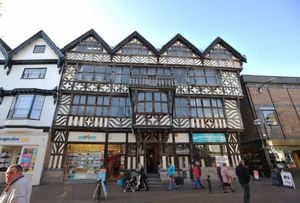Ancient High House at risk of being burnt down by vandals
Stafford's Ancient High House is at risk of being burnt down by vandals, it has been revealed.

Stafford Borough Council bosses have said there is a 'serious concern' the building, which is the largest timber framed town house in England, is 'vulnerable to fire' due to yobs discarding and putting out cigarettes on the timber ledges and timber work joints.
The timbers are more than 400 years old with the Ancient High House having been constructed in 1594.
A report prepared by Stafford Borough Council states: "Cigarettes and smoking materials are discovered in the porch on a daily basis – with cigarettes often discarded on the timber ledges – and on occasion pushed into the timber work joints.
“There is a serious concern the building is vulnerable to fire from these activities."
Bosses have also said the entrance to the historic building is being used as a toilet, while drug paraphernalia and piles of sick have also been found in the porch.
In response to the vandalism and anti-social behaviour, which has also seen the timber frame, stone steps and panels of the Grade-II listed building damaged, council bosses are hoping to install a gate and bars on the front of the building.
A planning application for the gate and bars has been submitted.
A statement with the application states: “In recent times the house has become a target for anti-social behaviour, with gangs frequently using the porch as a meeting point, refuge and shelter from weather.
“The people involved have been known to intimidate staff trying to enter the building.
“In addition to the anti-social behaviour displayed by many of the individuals involved, there have been numerous incidences of vandalism to the timber frame, stone steps and wattle and daub panels.
“There is continuous evidence of individuals urinating in the porch and against the front door, spitting on the steps and vomiting.
"Drug paraphernalia is also discovered here.
"As can be seen the situations above present health and safety concerns for the staff employed here – not least their having to clean up the above mentioned mess together with food and drink debris and discarded bottles and cans of alcohol."
The report continues: “The metal gates will add to the security of the listed building and although without historic precedent are not considered to cause harm to its significance.”
The structure, purchased and renovated by the council in 1976, was once host to royal guests including Charles I and Prince Rupert in 1642.
It opened as a museum in 1986 and it attracts around 20,000 visitors a year, including school children.





